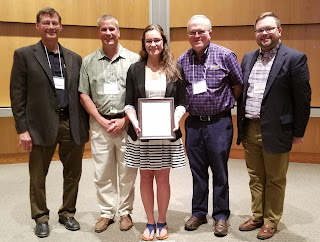The Biochemistry major has been popular with many of our students who plan careers in medicine. In the spring of 2019, five Biochemistry alumni earned their medical degrees.
 Dr. Daiva (Gerbec) Mitchell (’13) completed her MD at the University of Toledo School of Medicine (MD) in Spring 2019, and is currently a resident in Internal Medicine at the University of Pittsburgh Medical Center. Daiva writes,
Dr. Daiva (Gerbec) Mitchell (’13) completed her MD at the University of Toledo School of Medicine (MD) in Spring 2019, and is currently a resident in Internal Medicine at the University of Pittsburgh Medical Center. Daiva writes,
“Ashland University was the perfect school to prepare me for medical school and my career as a physician. With the small class sizes, I was able to get to know my professors and easily find mentors and research opportunities. Also, with Ashland's wide variety of clubs and groups, I was able to develop my professional and leadership skills while in college. Finally, with Ashland's focus on Christian values, I grew in my compassion for others which has impacted the way I care for my patients now.”
 Dr. Aaron Tipton (’13) also completed his MD at the University of Toledo School of Medicine (MD) in Spring 2019, and is a General Surgery resident at the Case Western Reserve University/University Hospitals Cleveland Medical Center. Aaron writes,
Dr. Aaron Tipton (’13) also completed his MD at the University of Toledo School of Medicine (MD) in Spring 2019, and is a General Surgery resident at the Case Western Reserve University/University Hospitals Cleveland Medical Center. Aaron writes,
“The experience at Ashland University prepared me for medical school in many ways from knowledge, critical thinking and a love for learning. Every class was taught by a professor who was passionate about the subject. They inspired me to become a lifelong learner, which is one of the most important traits of becoming a physician.”
 Dr. Kayla Prokopakis (’15) completed her DO at the Ohio University Heritage College of Osteopathic Medicine in Spring 2019, and is an Emergency Medicine resident at Mercy Health -St. Elizabeth Boardman Hospital in Boardman, Ohio.Kayla writes,
Dr. Kayla Prokopakis (’15) completed her DO at the Ohio University Heritage College of Osteopathic Medicine in Spring 2019, and is an Emergency Medicine resident at Mercy Health -St. Elizabeth Boardman Hospital in Boardman, Ohio.Kayla writes,
“Ashland University prepared me for medical school and my professional career in more ways than one. The science department and my academics at AU allowed me to establish great study habits and the knowledge and passion the professors had for teaching allowed me to thoroughly grasp concepts to build my medical education upon. Playing softball for AU allowed me to learn how to effectively work as a team, lead, and fostered a strong work ethic. The people of Ashland University and the community all want you to exceed and be successful in any field you chose which fosters a great environment to learn and grow. Overall, I believe I was accepted into medical school because of all of the opportunities AU allowed me to pursue and will forever be grateful for the education and relationships established there.”
 Dr. Amber McDermott (’15) also completed her DO at the Ohio University Heritage College of Osteopathic Medicine in Spring 2019, and is a Resident Physician at Aultman Hospital in Orthopedics. Amber writes,
Dr. Amber McDermott (’15) also completed her DO at the Ohio University Heritage College of Osteopathic Medicine in Spring 2019, and is a Resident Physician at Aultman Hospital in Orthopedics. Amber writes,
"My time at Ashland University was the greatest four years and played an instrumental part in preparing me for medical school. Both my commitment as a member of the softball team as well as my courses and professors in the science department I was able to build leadership skills, time management and study skills that helped me not only get through medical school, but excel. I am thankful for both coaches and professors that pushed me, small class sizes that let me build relationships with both my teachers and classmates, and a university that helped me get to where I wanted to be."
Dr. C.J. Hassmann (’15) received his degree from the Kent State University College of Podiatric Medicine (DPM) in Spring 2019 and is currently a Resident Physician at St. Rita's Medical Center in Lima, OH.
For information about the Biochemistry program, please contact Department of Chemistry, Geology & Physics Chair Dr. Rebecca Corbin.















